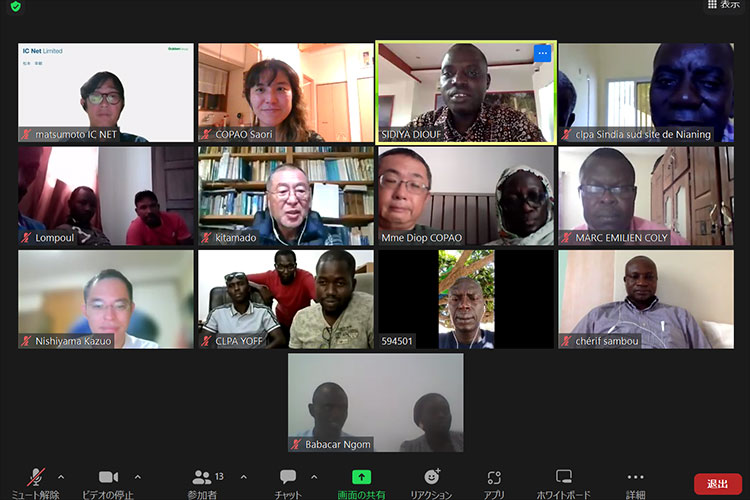2.3 Strengthening the collaboration between several fishing villages
In the management of fisheries resources that move and migrate over a wide area of the ocean, if one fishing village limits its catch but the others continue to fish without restriction, the resource will not recover, causing inequity between fishing villages; then, the resource will be mismanaged. In some cases, such as for catadromous sardinella (locally known as yaboi), which, depending on the season, migrates from north to south on Grande-Côte. Fishermen move with the migration of the school of fish, catch them, and land on the nearest beach, where they are sold as fresh or processed fish. In such cases, all fishing communities in the areas where the schools of fish move must ensure resource management.
Even when the resource is sedentary, not only do fishermen closest to the fishing area use the resource but those from other areas may catch the same resource, sometimes using different fishing methods. For example, it has been reported that local fishermen use gillnets to catch abundant cymbium shellfish (known locally as Yet) from Petite-Côte, while outsiders visiting the area catch them by diving. In such a case, all fishing communities that use the same resource should be the focus of resource management.
Thus, where resource management over a large area is required, collaboration between fishing communities is necessary for the co-management of resources. The actors who will take the lead in resource management through collaboration between several fishing villages should be the professional groups that make up the resource management organisations and their leaders; however, initially, it is likely to be the members of the organisations that take the lead in resource management activities, such as the Directorate of Fisheries, local authorities, and donors. These include the Directorate of Fisheries (central, regional, departmental, and district) that provides the legal framework and government research institutes that provide theoretical support for resource distribution and abundance.
The following describes how members of organisations that promote resource management activities, such as the Fisheries Directorate, local authorities, and donors, can work with resource management organisations to strengthen collaboration between fishing villages.
- Provide an opportunity to discuss issues related to collaboration between fishing villages
- Clarify the scope of collaboration and share knowledge of the issues
- Start collaboration when it is feasible
- Further ensure the results of the collaboration by order
Provide an opportunity to discuss issues related to collaboration between fishing villages.
Information will be gathered on resource management activities that require collaboration between fishing villages based on the characteristics of the resources to be managed and an opportunity will be created for these communities to identify problems and discuss collaboration in resource management activities. There are cases where some problems have already occurred and cases where potential problems may occur in the future.
Where problems have already emerged, the involvement of a third party, such as an administrative body, in the discussion can help make discussions more constructive. The lack of management issues may dissuade some fishing communities from participating in collaborative resource management activities. In these cases, fishing community leaders who are already implementing resource management activities can share their experiences with the meaning, methods, and necessity of resource management, future benefits, and their experience in overcoming technical and economic challenges. These activities will raise awareness among disinterested fishing communities and build momentum for collaboration.
12. Providing an opportunity for information sharing via regular Zoom meetings
COPAO, a JICA project, conducted a campaign to release juvenile cymbium in four villages (Lompoul and Fase Boye in Grand Côte, and Djifer and Nyaning in Petit Côte) in order to boost the villages’ interest in cymbium resources. Petit Côte, where cymbium has been purchased and exported by seafood export companies since the early 2000s, and Grand Côte, where cymbium is only a by-catch for bottom gillnet fishing as of 2023, differ in both the commercialisation stage of cymbium and the empirical knowledge of resource management activities. Thus, a Zoom meeting was held once a month for the four villages as an opportunity to exchange information, convey the Petit Côte experience to Grand Côte, and strengthen cooperation among the four villages.


Clarify the scope of collaboration and share knowledge of the issues.
Representatives of several fishing communities should meet to discuss and identify where a problem lies, the scope of activities to address the problem, and the magnitude of the involvement warranted to address the problem, such as collaboration between several fishing villages within the department, across several departments, or across several regions. These activities are important for highlighting potential problems, clarifying where they lie, and creating a common awareness of the problems among stakeholders.
When the nature of the problem requires nationwide resource management activities, for example, when a target species moves beyond the borders of the region or when fishermen are attracted to an area of high fishing activity beyond the region, government agencies, such as the Ministry of Fisheries and Maritime Economy, are called upon. In this case, national management organisations, such as the National Executive Bureau of the CLPA networks in Senegal, play a major role.
13. Expanded collaboration between community resource management organisations (CLPAs) in Senegal
In Senegal, the creation of the National Executive Bureau of the CLPA Network was the result of the momentum felt by each CLPA to deepen their understanding of resource management activities, share information with the relevant stakeholders, and establish a broader fisheries resource management system based on the characteristics and trends of the target resources.
Start collaboration when it is feasible.
With the support of structures that promote resource management activities, such as the Directorate of Fisheries, local authorities, and donors, the leaders of each fishing village should talk to the leaders of other fishing villages and collaborate where possible. As results of the collaborative activities are steadily achieved, the surrounding fishing communities will gradually show interest in the project. Through these efforts, the content of the collaboration will be gradually improved and the scope of the collaboration will be extended.
Further ensure the results of the collaboration by order.
Leaders of each fishing village should request the support of the administrations at every opportunity and ensure that agreements on resource management activities between fishing communities are enforceable as departmental or regional bylaws by local authorities, where penalties for non-compliant operations become legally binding. Administrations such as the Direction of Maritime Fisheries and local authorities should be involved in the process of collaboration between fishing communities from the beginning to ensure that the collaboration is proceeding in the right direction and to support the legal framework and coordination of the organisations involved in achieving better results from the collaboration.